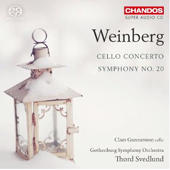

The impressive Chandos overview of the orchestral music of Mieczyslaw Weinberg (1919-1996) surges onward with the
release and world première recording of his Symphony No. 20, Op. 150 completed in 1988, as well as his 1948
Cello Concerto, Op. 43, a work that was premièred by Mstislav Rostropovich in 1957. Works from two distinctly different periods in
the composer's life, both in terms of emotional outlook and compositional output.
The symphony is somewhat structured like some of Mahler's symphonies, with two longer slow movements framing three much shorter inner fast
movements. By this point Weinberg no longer had to resort to blunt theatrical gestures to fully express his ideas, and therefore this symphony's
idiom, or vernacular if you may, is much more subdued and abstract. The personal and musical relationship between Weinberg and Shostakovich, and
especially the similarities of style, orchestration and utterance have always been obvious. After all they were life long friends. I believe the opening
Adagio movement of Weinberg's 20th, equals or even surpasses, some of the bleakest and most desolate moments within the symphonies
of Shostakovich himself. The effective harmonic modulation at the 2:15 mark is a typical Shostakovich trademark. Two hushed clarinets holding a confidential conversation against the desolate background of darkness, night, secrecy, as if
trying to avoid detection. The feeling of apprehension is palpable throughout the whole movement as the strings rise to ever increasing levels of dread.
The clarinets return to finish their conversation, surrounded by even darker shadows. This music is far from being oratorical and yet it says so much.
The second Scherzo (fourth movement) on the other hand, may be short at only 4:32, but it contains everything but the kitchen sink.
Loud, brash, and fast, gasping for breath, as if running for its life. It sets in motion all the separate groups of the orchestra from the percussion, to
the brass, woodwinds and strings, and eventually brings all of these forces together to end with a volley of punches. The plaintive final Lento
movement is the most baffling. After a series of long searing lines in the upper strings the music settles into an up-and-down six note motif that
eventually leads to an odd, strange, out of character passage for flute and percussion, from which the strings rise again to a soaring and gripping climax,
which in turn leads to the symphony's positive and powerful, yet enigmatic conclusion.
As in an earlier recording of Weinberg Concertos,
cellist Claes Gunnarsson, plays with a beautiful singing tone, and always projects the right emotion within the music. The
Cello Concerto, Op. 43 seems to go hand in hand with Gunnarsson's lyrical and ardent delivery. Written 40 years earlier, it's less
concerned with existential matters than with spirited musical discourse. It's a folk-inspired work that clearly exposes the composer's Jewish roots. The
beautiful opening melody establishes the work's provenance and it's ultimate conclusion, with a consistent thread throughout. Shostakovich's symphonies
and concertos seemed to be extensions of each other, whereas under Weinberg's treatment, they embrace different aspects of life. Symphonies bring
out the philosopher in Weinberg, whereas the concertos expose Weinberg the musician. The final movement in particular allows the cellist to spread
wide his expressive wings, and by revisiting the opening's material, brings the work to a beautifully fitting conclusion.
The Gothenburg Symphony Orchestra and conductor Thord Svedlund have been excellent advocates and
proponents for the music of Mieczyslaw Weinberg, with highly recommendable recordings in this Chandos
cycle, and this new release reinforces that fact and should add an extra chevron to their épaulettes. And I know I've said this many times before,
but if you enjoy the music of Shostakovich, odds are you will also enjoy the music of Weinberg. They shared the same ideals and outlook. And if I dare
say, I believe Weinberg was the more "musical" of the two. Highly Recommended!!
Jean-Yves Duperron - June 2012